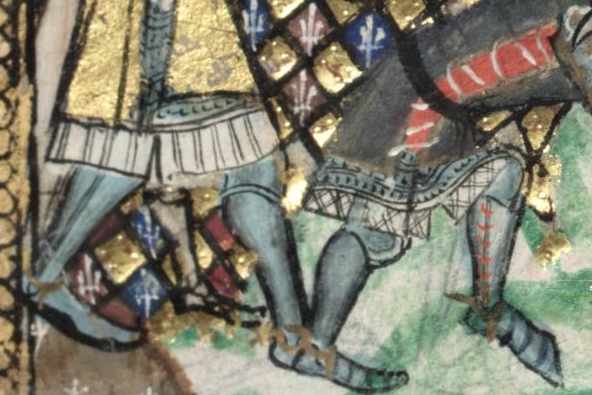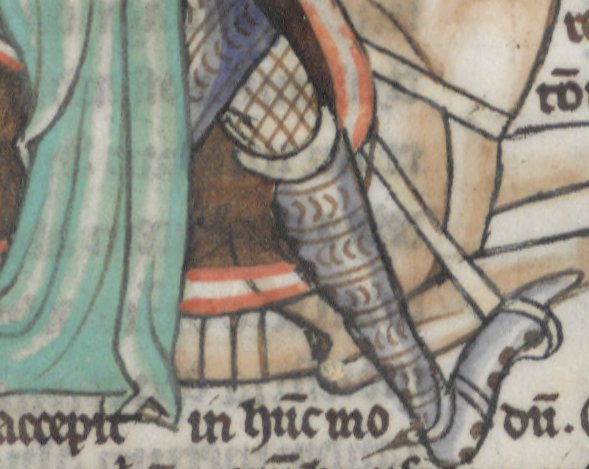| Author |
Message |
|
Lafayette C Curtis
|
 Posted: Tue 29 Apr, 2014 12:19 am Post subject: Quilting patterns in European armour? Posted: Tue 29 Apr, 2014 12:19 am Post subject: Quilting patterns in European armour? |
 |
|
I have a rather weird question here. When I look at medieval European illustrations of padded or quilted armour (especially the ones in this site's Features section), I usually see long, parallel quilting patterns, whether vertical (very common throughout), contoured (also quite common in arming doublets and gambesons from the mid-14th century onwards), or horizontal (less common but too widespread to be worth dismissing), with the addition of somewhat radial patterns (following the fold/pleat/tuck lines popular in contemporary fashion) in the 15th century. And when the quilting lines cross each other they tend to form rectangular segments (out of the intersections between horizontal and vertical quilting). However, many modern depictions (say, 19th-21st century) of medieval (and medieval fantasy) quilted armour often show lozenge-shaped quilting patterns, like this:

Just on an idle whim, I've been trying to figure out why, and here are some of the hypotheses I've come up with:
1. There's some lozenge-quilted medieval armour out there but I've missed it (most likely, since I vaguely recall seeing some sort of lozenge quilting on a late-medieval painting of a Biblical scene).
2. I may have seen some lozenge quilting on 16th-century European cloth jacks/jerkins, though I can't exactly remember where (and the jack shown in the Feature article has triangular patterns, not lozenge-shaped). If so, I have to wonder whether anybody has done any research about when this pattern became popular.
3. It's an interpretation of the lozenge-shaped patterns shown on some of the Bayeux Tapestry warriors, now usually seen as a variant depiction of mail.
4. 16th- and 17th-century depictions of foreign armour sometimes show lozenge quilting patterns -- the ones I remember most clearly are about Central American (Aztec?) warriors and Russian horse-archers, although I think I've seen lozenge quilting on some woodcuts or sketches of Chinese or Tibetan warriors too. And I'm pretty sure there's some lozenge quilting in 19th-century depictions of contemporary Indian armour and also of some African cavalry (Bornu? Mali?). The lozenge patterns seen in these depictions could have been extrapolated onto earlier European armour.
I suppose it's pretty obvious that I've been overthinking this. Anyway, I'm curious about whether others have tackled this subject and reached more solid conclusions than I have.
|
|
  |
 |
|
Timo Nieminen
|
 Posted: Tue 29 Apr, 2014 3:54 am Post subject: Posted: Tue 29 Apr, 2014 3:54 am Post subject: |
 |
|
Lozenge-quilting is a common quilting pattern in 19th-21st century civilian clothing (maybe the most common?). Maybe it's just assuming that similar quilting patterns were used for armour in the past.
"In addition to being efficient, all pole arms were quite nice to look at." - Cherney Berg, A hideous history of weapons, Collier 1963.
|
|
   |
 |
|
Mart Shearer
|
 Posted: Tue 29 Apr, 2014 7:25 am Post subject: Posted: Tue 29 Apr, 2014 7:25 am Post subject: |
 |
|
The Romance of Alexander, Ms. Bodl. 264, from 1338-1344 has only one example of diagonal crossed stitching on an aketon when all others are vertical. This can be seen on folio 54v. Crossed patterns are more common on gamboissed cuisses in the 13th and early 14th centuries.
http://gallica.bnf.fr/ark:/12148/btv1b6000541b/f156.item
http://image.ox.ac.uk/images/bodleian/ms.bodl.264/54v.jpg
 Attachment: 171.11 KB Attachment: 171.11 KB

MS Bodl. 264 fo 54v
 Attachment: 52.73 KB Attachment: 52.73 KB

BNF Lat. 8865 fo 71v
ferrum ferro acuitur et homo exacuit faciem amici sui
|
|
  |
 |
|
Lukas Schramm
Location: Cologne, Germany Joined: 29 Aug 2010
Posts: 7
|
 Posted: Tue 29 Apr, 2014 7:32 am Post subject: Posted: Tue 29 Apr, 2014 7:32 am Post subject: |
 |
|
I'd say, that this pattern of quilting originates from stuffing with loose material.
If multiple layers of fabric are quilted to improve the strength, then the quilting only has to run in one direction, as the fabric has quite a lot of structural integrity.
But if I only have two layers of fabric and some loose material stuffed in between, it is likely to clumb together over time. This would result in a garment with all the material clumbed together at the bottom, with a decrease in protection, the higher up you get. Or a cut in the outer layers would result in the spill of all the stuffing material.
Quilting in the pattern of small rectangles would help to prevent this.
|
|
  |
 |
|
Mart Shearer
|
 Posted: Tue 29 Apr, 2014 8:04 am Post subject: Posted: Tue 29 Apr, 2014 8:04 am Post subject: |
 |
|
Lukas,
I don't really agree. We have plenty of evidence for armors filled with loose cotton (cotton wool for the English) or tow, and both fibers tend to cling. The same factor which would cause fibers to clump would keep it from falling out of a cut shell. The effect of gravity on loose fill would be lessened by not hanging the garments up, but storing them in a chest laying down.
It could simply be that the reason we see less lozenge pattern stitching is that it took twice as long to do.
Another issue is the inventory records of jaserant armor, mail covered with fabric with the padding included. How can we tell from an image if these vambraces are sewn layered fabric, sewn stuffed fabric, sewn stuffed fabic with mail, etc.
http://manuscriptminiatures.com/4747/13675/
ferrum ferro acuitur et homo exacuit faciem amici sui
|
|
  |
 |
|
T. Kew
Location: London, UK Joined: 21 Apr 2012
Posts: 256
|
 Posted: Tue 29 Apr, 2014 10:27 am Post subject: Posted: Tue 29 Apr, 2014 10:27 am Post subject: |
 |
|
Also, the idea of the stuffing clumping together presupposes that you're leaving space in the garment for it to do so. The surviving padded examples seem to be packed pretty densely - if you look at the pictures of the Lubeck jack it's padded practically to bursting point. There's no space for the padding to slide around inside the garment.
I'm personally fairly confident that cross-quilted fabric armours were extremely rare compared to line-quilted ones.
|
|
  |
 |
|
Jeffrey Faulk
|
 Posted: Tue 29 Apr, 2014 11:07 am Post subject: Posted: Tue 29 Apr, 2014 11:07 am Post subject: |
 |
|
|
It strikes me that cross-quilting might take more time than straight line quilting, as well. Working with a garment as full as an arming doublet you really don't want to take more time than you really have to...
|
|
  |
 |
Dan Howard

|
 Posted: Tue 29 Apr, 2014 2:04 pm Post subject: Posted: Tue 29 Apr, 2014 2:04 pm Post subject: |
 |
|
| Mart Shearer wrote: | | The Romance of Alexander, Ms. Bodl. 264, from 1338-1344 has only one example of diagonal crossed stitching on an aketon when all others are vertical. This can be seen on folio 54v. Crossed patterns are more common on gamboissed cuisses in the 13th and early 14th centuries. |
It is generally accepted that the cross hatching on the Bayeux Tapestry is mail. Why can't your illustration simply be an attempt to render two different types of mail? We see similar attmpts on other illustrations with various combinations of lines and dots
Author: Bronze Age Military Equipment, Pen and Sword Books
|
|
  |
 |
Dan Howard

|
 Posted: Tue 29 Apr, 2014 2:07 pm Post subject: Posted: Tue 29 Apr, 2014 2:07 pm Post subject: |
 |
|
| T. Kew wrote: | | Also, the idea of the stuffing clumping together presupposes that you're leaving space in the garment for it to do so. The surviving padded examples seem to be packed pretty densely - if you look at the pictures of the Lubeck jack it's padded practically to bursting point. There's no space for the padding to slide around inside the garment. |
Stuffing was added first. The quilting was done afterwards to compress it.
Author: Bronze Age Military Equipment, Pen and Sword Books
|
|
  |
 |
|
Mart Shearer
|
 Posted: Tue 29 Apr, 2014 4:56 pm Post subject: Posted: Tue 29 Apr, 2014 4:56 pm Post subject: |
 |
|
| Dan Howard wrote: | | Mart Shearer wrote: | | The Romance of Alexander, Ms. Bodl. 264, from 1338-1344 has only one example of diagonal crossed stitching on an aketon when all others are vertical. This can be seen on folio 54v. Crossed patterns are more common on gamboissed cuisses in the 13th and early 14th centuries. |
It is generally accepted that the cross hatching on the Bayeux Tapestry is mail. Why can't your illustration simply be an attempt to render two different types of mail? We see similar attmpts on other illustrations with various combinations of lines and dots |
Within MS 264 there is a standard method of portraying mail, and a standard coloring. The armor appears in layers of a cyclas/surcoat worn over a pair of plates, worn over mail, worn over an aketon of whitish-buff coloration. I don't think comparing a manuscript miniature from the mid-14th century to a laid and couched embroidery of the late 11th century will allow a useful comparison of artistic conventions applicable to both. Cross-hatched lines are often used to portray mail in the 11th and early 12th century, as well as in the early 14th century Manesse Codex, but it does not seem to be used by this artist. While all art is interpretive, I am reminded of a quote from a pre-school grandchild of one of my professors, "Words are for people who can't read pictures."
Perhaps we should start a thread where we can compare the various conventions thought to represent mail over the centuries in various cultures and media? I have noticed a few chronological and regional trends.
ferrum ferro acuitur et homo exacuit faciem amici sui
|
|
  |
 |
|
Lafayette C Curtis
|
 Posted: Fri 16 May, 2014 4:07 am Post subject: Posted: Fri 16 May, 2014 4:07 am Post subject: |
 |
|
Hmm. Yes. I had missed the thing about modern quilted garments, probably since I live in a tropical country where quilted clothes are very rare on the street. On a different note, the illustration from MS Bodleian 264 does look more like quilting than mail to me, though there's no way to be sure. Unfortunately it still seems like a very rare case and not all that likely to be the source of lozenge quilting in modern depictions of medieval armour.
No problem. Won't hurt to go some more, since the search itself has been at least as fun as the results.
|
|
  |
 |
|
|
You cannot post new topics in this forum
You cannot reply to topics in this forum
You cannot edit your posts in this forum
You cannot delete your posts in this forum
You cannot vote in polls in this forum
You cannot attach files in this forum
You can download files in this forum
|
All contents © Copyright 2003-2025 myArmoury.com — All rights reserved
Discussion forums powered by phpBB © The phpBB Group
Switch to the Basic Low-bandwidth Version of the forum
|

